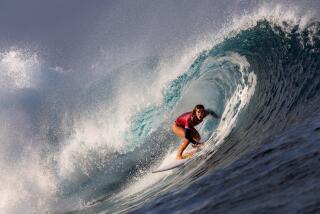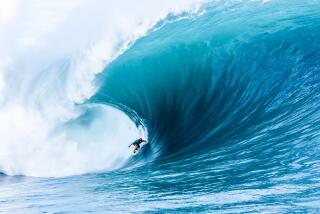Surfing Magazine : Catches Long Wave : Kept afloat by apparel ads, the journal marks its 25th year. As it gets older, its readership grows younger.
- Share via
You’d think that after 25 years in the Southern California sunshine, Surfing magazine would be all dried up.
Sure, it’s changed. It started in the early 1960s with breathless stories about surfing awards banquets, progressed to spiritualistic stream of consciousness in the ‘70s and turned to adolescence in the ‘80s.
Bikinis and boards are smaller, readers are younger and the photography is glossier. Perhaps the biggest change, though, is in the abundant advertising and its focus on the billion dollar surfwear industry.
When the magazine started out, very few ads broke up the big blue waves on the magazine’s pages; but as Surfing celebrates its 25th anniversary, the magazine flourishes with a lot of help from an industry that it helped to create--beachwear. Today, surf publishing and apparel would drown if they had to paddle out into the business world separately.
“Without them (surf magazines), we can’t reach the consumer,” said Jerry Crosby, executive vice president of marketing for Ocean Pacific Sunwear. “Without us (manufacturers), they may not be around. It is an informal co-dependency that we find ourselves in.”
The San Clemente magazine, founded by two surfers, marks its Silver Anniversary with a paid circulation of 114,000 in 50 states and 35 foreign countries--more than five times its initial output in 1964.
Lots of other differences exist, too. The magazine started out as International Surfing with only 68 pages. The “international” was dropped in 1968, and today Surfing averages 175 pages per month, said Editor David Gilovich.
Each issue generally sports more ad pages than the first issue had in total pages, and Surfing has apparel manufacturers to thank for that. While early issues boasted mostly surfboard ads, today beachwear advertising accounts for nearly 50% of Surfing’s $3.25 million in ad revenue.
In addition, Surfing prints an annual “summer fashion preview,” stuffed with clothing brands such as Bad Dog, Billabong and Body Glove. The 1988 fashion issue ran 220 pages, a magazine that Publisher Bob Mignogna contends was “the largest issue of a surf magazine in history.”
“In our first 15 years of publishing, the surfing industry in terms of dollars was very small,” said Mignogna, who’s been with Surfing for 15 years. “It started out as a cottage industry. Until about 1975, all the major companies were surfboard manufacturers.”
Today, between 300 and 400 apparel makers specialize in surf-flavored fashions, of which about 70 are in Orange County, the U.S. hub of surf manufacturing and publishing.
Brad Bonhall, editor of Action Sports Retailer in South Laguna, estimates that $1.5 billion is spent in the United States each year on beachwear alone. And he says that few manufacturers can afford not to advertise in both Surfing and Surfer, a San Juan Capistrano competitor founded in 1960 that has a monthly paid circulation of 112,000.
The circulation figures for Surfing and Surfer are healthy for a specialty publication, according to Bilal Said, a publishing industry analyst for S. G. Warburg & Co. in New York. And what’s more important, he says, is that an ad in Surfer or Surfing gets straight to the consumer core that apparel manufacturers want to reach.
For while beachwear has appeal beyond the million or so U.S. surfers, Mignogna says, “the basic premise is that your product has to be worn by authentic surfers if it is going to be considered on the cutting edge.”
While the two magazines are equally important to manufacturers, they have vastly different images.
Surfer is “the Bible” of surf publications, said Danny Kwock, marketing director for Quiksilver Inc. of Costa Mesa. “Surfing is the avant-garde, the hip, rock ‘n’ roll, on-the-edge publication.”
Who reads Surfing? Well, here’s a clue from one letter-to-the-editor out of La Jolla:
“Now, the reason I am writing this letter is to let everyone know just what I think about life,” writes Aaron Klein in Surfing’s February edition. “Granted, at 17 years old, I may not know everything but I have been surfing for 10 of those years so I think I know something about the life style.”
He goes on to catalogue what’s hot and what’s not in his own wet world. Hot: Surfing, skateboarding, snow boarding, jet skiing, bikini contests. Not: Offshore oil rigs, nuclear war, President Reagan.
Like Klein, the magazine’s average reader falls within a very small sub-group of the world’s population: He’s a male, somewhere between 16 and 18 years old. He lives in a beach town, is just finishing up high school or barely entering college.
And that’s what makes Surfing so valuable to the manufacturer of surf clothes, says Ocean Pacific’s Crosby.
“Our target audience is 12 to 24,” Crosby says. “Surfing has less wasted distribution for us. Most people in our industry have a similar target audience if they really thought about it.”
More Younger Readers
But Surfing’s reader wasn’t always quite so young. When the magazine started demographic studies in 1976, it found its readers were 20 to 21 years old. For the next 10 years, Mignogna said, the readers got progressively younger, with more sporting orthodontia than using razors.
It’s not that the older readers surfed off into the sunset. There’s just been a “huge increase” in the number of younger readers, says Gilovich. As a result, the magazine has pitched its pages a peg lower.
In 1966, for example, the magazine published a paean to Duke Kahanamoku, the father of modern day surfing who is credited with introducing the sport to California and Australia. Kahanamoku, the magazine gushed, “has done more for Hawaii than all the hula girls and Hawaiian Visitors Bureau posters combined.”
Fast-forward to 1973, when stream-of-consciousness hit the pages: “There aren’t any new surfers, the new faces are faceless, as you are paddling out again for your second wave, moving never fast enough against the lateral current along the white edge of the turned-over water scar, watching out to where the walls first show.”
And what does 1989 look like in comparison? The ads sport fresh-faced, tanned boys and girls. In the February issue, a feature called “Star Boards” asks champion surfers--most very recent drivers--about their favorite equipment. And “Getting a New Board Wired” tells board buyers to go slowly at first:
“When you get a new board,” the advice column cautions, “you’re pumped and you expect it to go unreal. But if you take off on your first wave and try to pull 15 off-the-lips, you’re likely to get bummed out when you suddenly discover you can’t.”
Different Approaches
The competition, however, is not willing to concede the younger reader. Nor does Surfer magazine give Surfing much credit for, well, much of anything. Peter Holmes, Surfer’s editor in chief, calls his magazine “a little more profound, in depth.”
“They (Surfing) tend toward the personality and making of stars, if you like,” Holmes contends. “We’re more concerned with the experience of surfing and so regard all surfers as equals in the water.”
But profundity does not ensure advertising. While Surfing boasted advertising revenue of $3.25 million in 1988, Surfer lagged a bit behind, with ad revenue of $3 million, Holmes said.
Western Empire Publications became Surfing’s fourth owner in 1979, Mignogna said. After 3 break-even years, the magazine and its parent company, which also publishes Body Boarding, have both been profitable.
So the magazine is saying thank you to all those surfers who made it possible with three anniversary editions that dive to the heart of the surfing experience. “The Surfboard” has already floated by, but brace yourself for “Waves” in June and “Surfers” in November.
Interspersed among those special editions are regular features such as the summer swimsuit preview, an all-Hawaii issue and the annual pro surfing U.S.A. edition.







